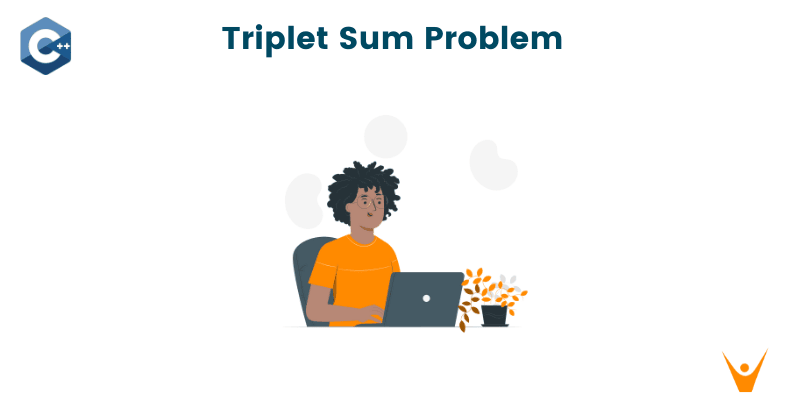The Triplet Sum Problem has applications in various domains, including data analysis, algorithms, and competitive programming. In this article, we will delve into the intricacies of the Triplet Sum Problem and explore different algorithms to solve it efficiently.
What is Triplet Sum Problem?
Triplet sum is a common problem in computer science that involves finding three elements in an array whose sum equals a given target value.
Basically, in this problem, you are given an array of integers and a target value, the triplet sum problem requires finding three elements from the array whose sum equals the given target. The solution should return all unique triplets that satisfy this condition. It is important to note that the elements in the triplets must be distinct.
Let's take an example to understand it. Given the array [1, 4, 2, 3, 0, 5, -1] and a target sum of 6, we need to find the triplets that sum up to 6.
Using the Two-Pointer approach, we can find the following triplets
- (1, 2, 3)
- (0, 2, 4)
- (1, 3, 2)
The algorithm iterates through the array and identifies the unique triplets whose sum equals the target value. In this case, the triplets are found by selecting the elements [1, 2, 3], [0, 2, 4], and [1, 3, 2]. These triplets satisfy the condition where the sum of each triplet is equal to the target value of 6.
Note that the order of the elements within each triplet may vary. For example, the triplet (1, 2, 3) can also be represented as (2, 1, 3) or (3, 2, 1). However, the algorithm ensures that only unique triplets are considered, regardless of the order of the elements.
There are 3 algorithmic approaches to solving it:
-
Brute Force Approach: The simplest approach to solve the triplet sum problem is to employ a brute force technique. It involves using three nested loops to iterate over all possible combinations of three elements from the array.
-
Two-Pointer Approach: A better approach to solving this problem is the Two-Pointer technique. It involves sorting the array in ascending order and then using two pointers: one from the left and another from the right.
-
Hashing Approach: In situations where the array is unsorted, a hashing-based approach can be employed to solve the triplet sum problem efficiently.
The brute force is not so efficient because its time complexity is O(n^3), where n is the size of the array. So, we will not discuss it. We will now study both the two-pointer and hashing approaches.
Two-Pointer Approach for Triplet Sum Problem
The Two-Pointer approach takes advantage of the fact that the array is typically sorted. It involves sorting the array in ascending order. Then, we will use two pointers: one starting from the left (low index) and another from the right (high index).
By moving these pointers inward based on the sum compared with the target value, the algorithm finds the desired triplets. The time complexity of this approach is O(n^2), where n is the size of the array, making it significantly faster than the brute force method.
Following is the C++ implementation for Two-Ponter Approach to solve the Triplet Sum Problem:
#include #include #include using namespace std; vector<vector<int>> findTriplets(vector<int>& nums, int target) { vector<vector<int>> result; // Sorting the array in ascending order sort(nums.begin(), nums.end()); int n = nums.size(); for (int i = 0; i < n - 2; i++) { // Skipping duplicate elements if (i > 0 && nums[i] == nums[i - 1]) continue; int left = i + 1; int right = n - 1; while (left < right) { int sum = nums[i] + nums[left] + nums[right]; if (sum == target) { result.push_back({ nums[i], nums[left], nums[right] }); // Skipping duplicate elements while (left < right && nums[left] == nums[left + 1]) left++; while (left < right && nums[right] == nums[right - 1]) right--; left++; right--; } else if (sum < target) { left++; } else { right--; } } } return result; } int main() { vector<int> nums = { 1, 4, 2, 3, 0, 5, -1 }; int target = 6; vector<vector<int>> triplets = findTriplets(nums, target); // Displaying the triplets that sum up to the target value for (const auto& triplet : triplets) { cout << "("; for (int i = 0; i < 3; i++) { cout << triplet[i]; if (i != 2) cout << ", "; } cout << ")" << endl; } return 0; }
Output:
(-1, 2, 5) (-1, 3, 4) (0, 1, 5) (0, 2, 4) (1, 2, 3)
In this code, we define the findTriplets function that takes an array (nums) and a target value as parameters. The function uses the Two-Pointer approach to find all unique triplets whose sum equals the target value. The algorithm first sorts the array in ascending order and then iterates through it using a loop.
Within the loop, two pointers (left and right) are initialized to find the remaining two elements. If the sum of the current triplet matches the target value, it is added to the result vector. The algorithm skips duplicate elements and continues searching for other possible triplets. Finally, it returns the result vector containing all the triplets.
In the main function, we demonstrate the usage of the findTriplets function by providing an array of integers (nums) and a target value. The code calls the function and then displays the found triplets that sum up to the target value.
Running this code will output the unique triplets (if any) whose sum is equal to the target value, providing a solution to the triplet sum problem.
The Two-Pointers Approach for Triplet Sum Problem has a time complexity of O(n^2) because it uses nested loops to find the triplets. The sorting operation adds an additional O(n log n) time complexity. Overall, the code efficiently finds the triplets in quadratic time, making it faster than the brute force approach.
The space complexity is O(1) because the additional space used is minimal and does not depend on the input size.
Hashing Approach for Triplet Sum Problem
This Hashing approach involves using a hash table or a set to store the complement values required to reach the target sum. The algorithm iterates through the array and for each element, it checks if the required complement value exists in the hash table. If found, a triplet is formed.
Here's a C++ code that utilizes the hashing approach to find triplets that sum up to a given target value:
#include #include #include using namespace std; vector<vector<int>> findTriplets(vector<int>& nums, int target) { vector<vector<int>> result; int n = nums.size(); for (int i = 0; i < n - 2; i++) { unordered_set<int> seen; int currTarget = target - nums[i]; for (int j = i + 1; j < n; j++) { int complement = currTarget - nums[j]; if (seen.count(complement)) { result.push_back({ nums[i], complement, nums[j] }); while (j + 1 < n && nums[j] == nums[j + 1]) j++; } seen.insert(nums[j]); } } return result; } int main() { vector<int> nums = { 1, 4, 2, 3, 0, 5, -1 }; int target = 6; vector<vector<int>> triplets = findTriplets(nums, target); // Displaying the triplets that sum up to the target value for (const auto& triplet : triplets) { cout << "("; for (int i = 0; i < 3; i++) { cout << triplet[i]; if (i != 2) cout << ", "; } cout << ")" << endl; } return 0; }
Output:
(1, 2, 3) (1, 0, 5) (4, 2, 0) (4, 3, -1) (2, 5, -1)
In this modified code, we use an unordered set (seen) to store the complement values required to reach the target sum. We iterate through the array, and for each element, we calculate the complement needed to reach the target. If the complement is found in the seen set, we have found a triplet that sums up the target value. We then add it to the result vector.
The time complexity of the Hashing Approach is O(n^2), where n is the size of the input array. The outer loop iterates n - 2 times, and the inner loop iterates n times in the worst case.
Applications of the Triplet Sum Problem
Following are some of the main applications of this problem:
-
Financial Analysis: In finance, the triplet sum problem can be used to identify potential investment opportunities. By searching for triplets of values that sum up to a desired target (such as a specific return on investment), analysts can discover combinations of assets or portfolios that meet their investment criteria.
-
Cryptography: In some cryptographic algorithms, this problem can be utilized to find combinations of keys or values that satisfy specific security conditions. By constructing triplets that satisfy cryptographic equations, secure cryptographic protocols can be implemented.
- Data Analysis: In data analysis and statistics, this problem can be applied to identify patterns or relationships in datasets.
Conclusion
So, Triplet Sum Problem is a famous programming concept that has many interesting solutions. The insights gained from studying this problem can be helpful in developing optimized solutions for a wide range of algorithmic challenges.








